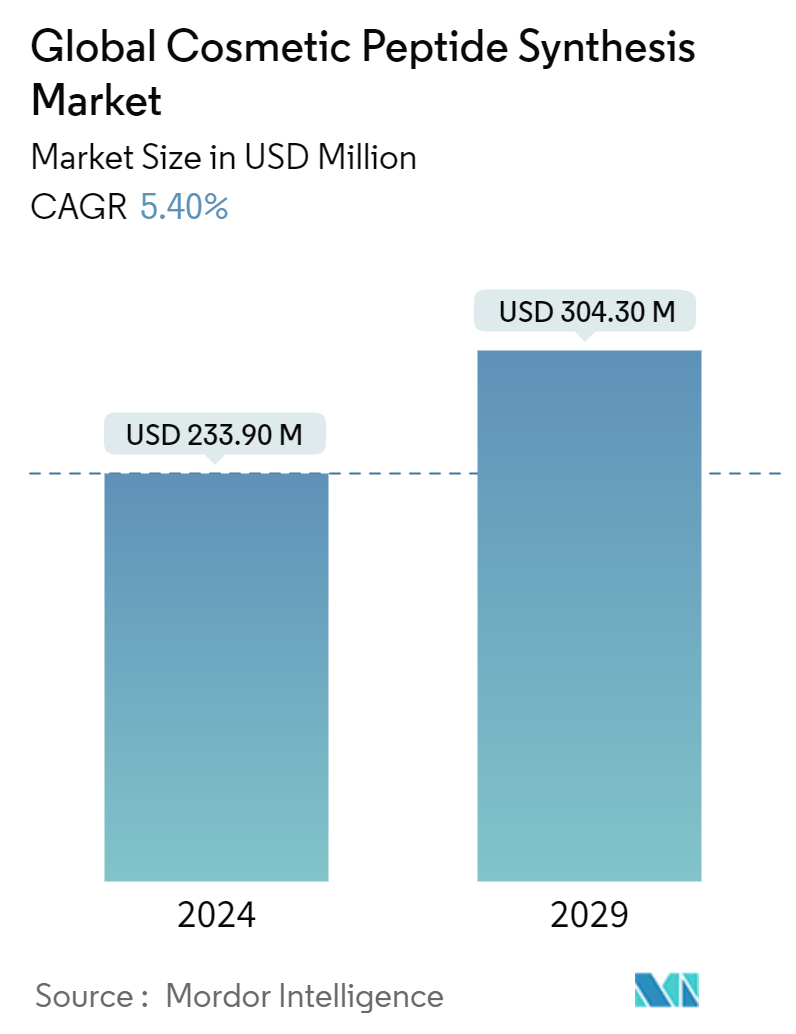Market Size of Global Cosmetic Peptide Synthesis Industry

| Study Period | 2019 - 2029 |
| Market Size (2024) | USD 233.90 Million |
| Market Size (2029) | USD 304.30 Million |
| CAGR (2024 - 2029) | 5.40 % |
| Fastest Growing Market | Asia-Pacific |
| Largest Market | North America |
| Market Concentration | Medium |
Major Players
*Disclaimer: Major Players sorted in no particular order |
Cosmetic Peptide Synthesis Market Analysis
The Global Cosmetic Peptide Synthesis Market size is estimated at USD 233.90 million in 2024, and is expected to reach USD 304.30 million by 2029, growing at a CAGR of 5.40% during the forecast period (2024-2029).
COVID-19 had an adverse impact on the cosmetic industry including the cosmetic peptide synthesis industry. For instance, the research study published in October 2021 stated significant differences in cosmetic usage. The article predicted that cosmetic usage would revert back to pre-COVID levels for eye, lip, and skin cosmetics after 1-2 years. Despite that, the United States Cosmetic Industry expected a significant decline in 2020. Similarly, another article published in October 2020 in the International Journal of Eating Disorders titled stated that the study led by researchers from Swinburne's Centre for Mental Health (CMH) has found that while most people reported spending less time investing in their appearance since COVID-19 began, individuals with high dysmorphic concern continued to feel self-conscious about their appearance. However, the studied market has been recovering over the last two years since the cosmetic peptide synthesis restrictions were lifted. The market will require another 1-2 years to show a stable growth rate.
In addition, the increasing prevalence of eye and skin disorders and increasing research and development activities are actively affecting the growth of the studied market.
Several cosmetic peptides, such as Acetyl Tetrapeptide-5 and Dipeptide-2, improve lymphatic circulation and are often used in eye creams aiming to combat dark and puffy under-eye circles. Peptides like oligopeptide-34 and nonapeptide-1 are used for treating skin pigmentation. For instance, according to a research article published in Karger Journal in May 2021, it has been observed that people with dark skin (South/Southeast Asian, Hispanic/Latin American, and African descent) have a high prevalence of pigmentary disorders. The same source stated that pigmentary disorders are the third and fourth more common dermatoses in Blacks and Hispanics, respectively. Thus, the high prevalence of pigmentation disorders and the advantages of cosmetic peptide in correcting skin pigmentation is expected to propel the cosmetic peptide synthesis market during the forecast period.
Furthermore, researchers have shown that several peptides have the ability to promote wound healing, cell migration, and angiogenesis. Cosmetic peptides have applications in eye care, aging, and pigmentation advantages, and various clinical trials are being conducted to validate the advantages. For instance, in a clinical trial published in Clinical Aesthetic Dermatology Journal in May 2021, the enhanced peptide-based serum combines five neuromodulating peptides, which target pre- and postsynaptic pathways at the neuromuscular junction to induce muscle relaxation and attenuate facial expression, thus minimizing the formation of expression lines. These peptides were scientifically demonstrated to have statistical significance in lowering the appearance of facial lines, eye lines, and eye wrinkles at a maximum smile and facial rest relative to baseline. The rising trials using cosmetic peptides and the advantages offered are expected to propel the market growth during the forecast period.
Therefore, owing to the aforementioned factors, such as rising demand for cosmetic peptides for various applications and increasing product launches, the studied market is anticipated to witness growth over the analysis period. However, stringent regulation for the approval of cosmetic peptides is likely to impede market growth.
Cosmetic Peptide Synthesis Industry Segmentation
As per the scope of the report, cosmetic peptides are a unique class of highly active and specific pharmaceutical compounds, molecularly poised between small molecules and proteins yet biochemically and therapeutically diverse from both. Bioactive peptides have been widely used in cosmetics to provide whitening, anti-aging, and skin repair effects. The Cosmetic Peptide Synthesis Market is segmented by Application (Anti-Aging, Eye Care, Anti Pigmentation, and Hair Growth), End User (Pharmaceutical & Biotechnology Companies, Contract Development and Manufacturing Organizations (CDMO), and Academic and Research Institutes), and Geography (North America, Europe, Asia-Pacific, and Rest of the World). The market report also covers the estimated market sizes and trends for 17 different countries across major regions globally. The report offers the value (in USD million) for the above-mentioned segments.
| By Application | |
| Anti-Aging | |
| Eye Care | |
| Anti Pigmentation | |
| Hair Growth |
| By End User | |
| Pharmaceutical and Biotechnology Companies | |
| Contract Development and Manufacturing Organization (CDMO) | |
| Academic and Research Institutes |
| Geography | ||||||||
| ||||||||
| ||||||||
| ||||||||
| ||||||||
|
Global Cosmetic Peptide Synthesis Market Size Summary
The cosmetic peptide synthesis market is poised for growth, driven by increasing demand for peptides in various applications such as anti-aging, skin pigmentation correction, and eye care. The market is recovering from the adverse impacts of COVID-19, with a projected steady growth trajectory over the forecast period. The rising prevalence of skin and eye disorders, coupled with advancements in research and development, is significantly influencing market dynamics. Cosmetic peptides like Acetyl Tetrapeptide-5 and Dipeptide-2 are gaining traction for their benefits in improving lymphatic circulation and addressing pigmentation issues, particularly in populations with a high prevalence of pigmentary disorders. The market is also witnessing a surge in clinical trials validating the efficacy of peptide-based products, further propelling market expansion.
North America is expected to dominate the cosmetic peptide synthesis market, supported by substantial investments in research and development and a growing geriatric population seeking anti-aging solutions. Strategic initiatives by key players, including partnerships and product innovations, are enhancing market competitiveness. Companies like BASF and ADOREYES are expanding their product offerings and geographical reach, contributing to market growth. The introduction of new peptides and formulations aimed at addressing skin and hair loss disorders is creating lucrative opportunities for market players. Despite the promising growth prospects, the market faces challenges due to stringent regulatory requirements for cosmetic peptide approvals.
Global Cosmetic Peptide Synthesis Market Size - Table of Contents
-
1. MARKET DYNAMICS
-
1.1 Market Overview
-
1.2 Market Drivers
-
1.2.1 Increasing Prevalence of Eye and Skin Disorders
-
1.2.2 Increasing Research and Development Activities
-
-
1.3 Market Restraints
-
1.3.1 Stringent Regulation for Approval of Cosmetic Peptide
-
-
1.4 Porter Five Forces
-
1.4.1 Threat of New Entrants
-
1.4.2 Bargaining Power of Buyers/Consumers
-
1.4.3 Bargaining Power of Suppliers
-
1.4.4 Threat of Substitute Products
-
1.4.5 Intensity of Competitive Rivalry
-
-
-
2. MARKET SEGMENTATION (Market Size by Value - USD million)
-
2.1 By Application
-
2.1.1 Anti-Aging
-
2.1.2 Eye Care
-
2.1.3 Anti Pigmentation
-
2.1.4 Hair Growth
-
-
2.2 By End User
-
2.2.1 Pharmaceutical and Biotechnology Companies
-
2.2.2 Contract Development and Manufacturing Organization (CDMO)
-
2.2.3 Academic and Research Institutes
-
-
2.3 Geography
-
2.3.1 North America
-
2.3.1.1 United States
-
2.3.1.2 Canada
-
2.3.1.3 Mexico
-
-
2.3.2 Europe
-
2.3.2.1 Germany
-
2.3.2.2 United Kingdom
-
2.3.2.3 France
-
2.3.2.4 Italy
-
2.3.2.5 Spain
-
2.3.2.6 Rest of Europe
-
-
2.3.3 Asia-Pacific
-
2.3.3.1 China
-
2.3.3.2 Japan
-
2.3.3.3 India
-
2.3.3.4 Australia
-
2.3.3.5 South Korea
-
2.3.3.6 Rest of Asia-Pacific
-
-
2.3.4 Middle East and Africa
-
2.3.4.1 GCC
-
2.3.4.2 South Africa
-
2.3.4.3 Rest of Middle East and Africa
-
-
2.3.5 South America
-
2.3.5.1 Brazil
-
2.3.5.2 Argentina
-
2.3.5.3 Rest of South America
-
-
-
Global Cosmetic Peptide Synthesis Market Size FAQs
How big is the Global Cosmetic Peptide Synthesis Market?
The Global Cosmetic Peptide Synthesis Market size is expected to reach USD 233.90 million in 2024 and grow at a CAGR of 5.40% to reach USD 304.30 million by 2029.
What is the current Global Cosmetic Peptide Synthesis Market size?
In 2024, the Global Cosmetic Peptide Synthesis Market size is expected to reach USD 233.90 million.

